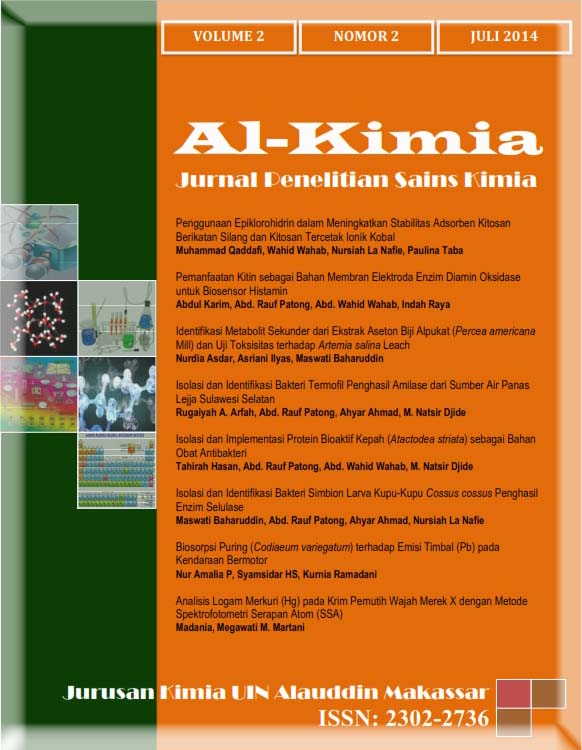Penggunaan Epiklorohidrin Dalam Meningkatkan Stabilitas Adsorben Kitosan Berikatan Silang Dan Kitosan Tercetak Ionik Kobal
Abstract
The use of epichlorohydrin to improve the stability of chitosan adsorbent has been carried out. The purpose of this study was to determine the stability of the chitosan adsorbent after modified into epichlorohydrin cross-linked chitosan and ionic cobalt imprinted adsorbent chitosan cross-linked epichlorohydrin. Adsorbent prepared by homogeneous gel formation of chitosan in acetic acid medium and then modified into epichlorohydrin cross-linked chitosan beads and ionic cobalt imprinted adsorbent chitosan cross-linked epichlorohydrin. Stability of the adsorbent was determined by calculating the percentage of insoluble material after stirring the adsorbent in nitric acid medium at pH 1, 2, and 3 for 12 hours. The results of FTIR spectra show a shift of the absorption band of chitosan were compared with epichlorohydrin cross-linked chitosan and ionic cobalt imprinted adsorbent chitosan cross-linked epichlorohydrin. The use of epichlorohydrin as cross-linked agent may increase the stability of the adsorbent to maintain the percentage of insoluble material by 89% at pH 3 for epichlorohydrin cross-linked chitosan adsorbent and 96% at pH 3 for ionic cobalt imprinted adsorbent chitosan cross- linked epichlorohydrin.
Downloads
References
Arifin, A., 2006, Keberadaan Sumber Daya Kobal Indonesia dan Kemungkinan Pengembangannya ke Depan, Metalurgi, 21 (2).
Cao, Z., Ge, H., Lai, S., 2001, Studies on Synthesis and Adsorption Properties of Chitosan Cross-Linked by Glutaraldehyde and Cu(II) as Template Under Microwave Irradiation, J. Eur. Polym., 372: 141–2143.
Chen, A. H., Liu, S. C., Yuan, C. Y., Yun, C. C., 2008, Comparative Adsorption of Cu(II), Zn(II), and Pb(II) Ions in Aqueous Solution on the Crosslinked Chitosan with Epichlorohydrin, J.of Hazard. Mater., 154, 184–19.
Chen, A., Yang, C. Y., Chen, C. Y., Chen, C. W., 2009, The Chemically Crosslinked Metal-Complexed Chitosans for Comparative Adsorptions of Cu(II), Zn(II), Ni(II) and Pb(II) Ions in Aqueous Medium, J.of Hazard. Mater, 163: 1068–1075.
Debbaudta. L., Ferreira, M. L., Gschaider, M. E., 2004, Theoretical and Experimental Study of M2+ Adsorption on Biopolymers. III. Comparative Kinetic Pattern of Pb, Hg and Cd, J. Carbohydr Polymers, 56: 321–332.
Haijia, S., Wang, Z., Tan, T., 2003, Adsorption of Ni2+ on the Surface of Molecularly Imprinted Adsorbent from Penicillium Chysogenum Mycelium, Biotech Letters, 25: 949–953.
Herwanto, B., Santoso, E., 2006, Adsorbsi Ion logam Pb(II) pada Membran Selulosa-Kitosan Terikat Silang, J. Akt. Kim., 2 (1)
Li, C. B., Hein, C. B., Wang, K., 2008, Biosorption of Chitin and Chitosan, J. Mater. Sci. and Tech., 24 (9).
Monteiro, O. A. C., Airoldi, C., 1999, Some Studi of Crosslinking Chtosan- Glutaraldehyde Inteaction in a Homogeneous System, Int. J. Biol. Macromol., 26: 119-128.
Varma, A. J., Deshpande, A. J., Kennedy, J. F., 2004, Metal Complexation by Chitosn and its Derivatives; A Review, J. Carbohydr. Polym., 55: 77–93.
Volesky, B. and Holan Z. R., 1995, Biosorption of heavy metals. Biotechnol.
Prog. 11, 235-250. in: Figueira M. M., et al., (2000) Biosorption of
Metals in Brown Seaweed Biomass, Wat. Res, 34 (1): 196-204.
Authors who publish with this journal agree to the following terms:
1) Authors retain copyright and grant the journal right of first publication with the work simultaneously licensed under a Creative Commons Attribution License that allows others to share the work with an acknowledgement of the work's authorship and initial publication in this journal.
2) Authors are able to enter into separate, additional contractual arrangements for the non-exclusive distribution of the journal's published version of the work (e.g., post it to an institutional repository or publish it in a book), with an acknowledgement of its initial publication in this journal.
3)Authors are permitted and encouraged to post their work online (e.g., in institutional repositories or on their website) prior to and during the submission process, as it can lead to productive exchanges, as well as earlier and greater citation of published work (See The Effect of Open Access).


